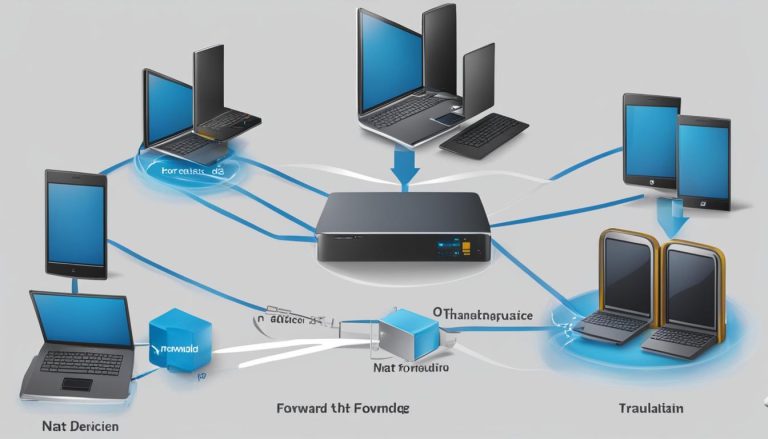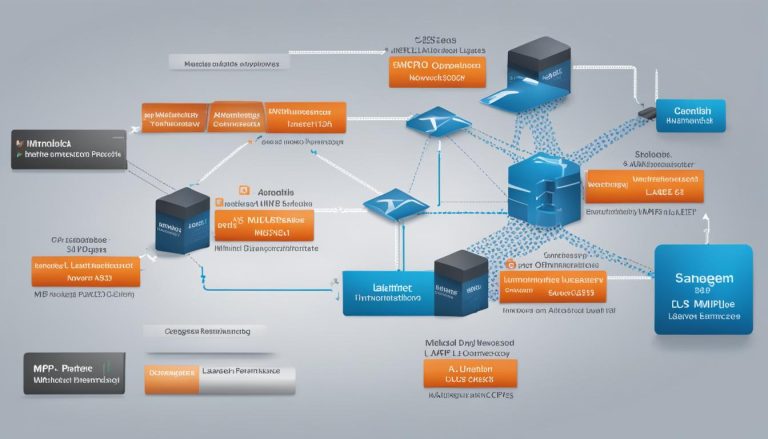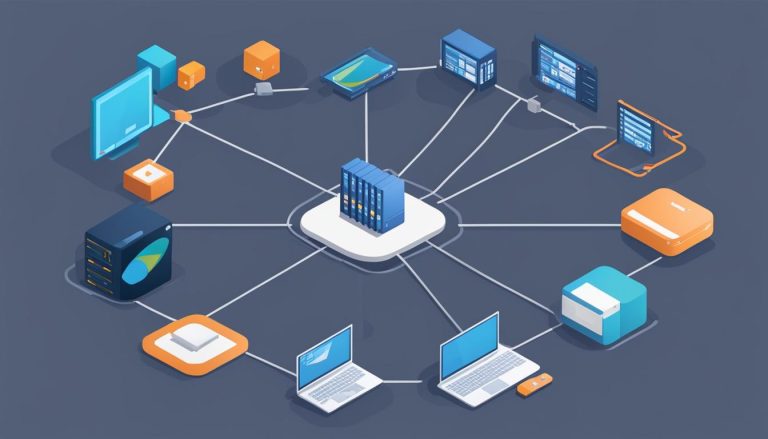DevOps, an amalgamation of “Development” and “Operations,” is a cultural and technical movement that revolutionizes the software industry. It bridges the gap between software development and IT operations, fostering collaboration, automation, and continuous improvement. DevOps aims to streamline software delivery by breaking down silos and promoting a culture of shared responsibility.
DevOps is centered around key principles such as automation, continuous integration, and continuous delivery, ensuring reliable and efficient software releases. By embracing DevOps, organizations can enhance collaboration among teams, improve software development processes, and ultimately deliver high-quality products to market faster.
Key Takeaways:
- DevOps bridges the gap between software development and IT operations
- It emphasizes collaboration, automation, and continuous improvement
- DevOps focuses on automation, continuous integration, and continuous delivery
- Shared responsibility and breaking down silos are central to DevOps principles
- Implementing DevOps can lead to faster and more reliable software delivery
Understanding the Difference Between DevOps and SRE
DevOps and Site Reliability Engineering (SRE) are two pivotal roles in the tech industry. While they share some common goals, their approaches and methodologies differ. DevOps is a cultural shift that emphasizes collaboration, communication, and integration across teams. It does not prescribe specific metrics and focuses on improving the overall software delivery lifecycle. On the other hand, SRE applies software engineering principles to operational challenges. It introduces metrics like Service Level Indicators (SLIs) and Service Level Objectives (SLOs) to measure and maintain service reliability. SRE focuses on the reliability, scalability, and performance of services.
While there is an overlap in the principles of DevOps and SRE, the key differences lie in their focus and approach. DevOps focuses on streamlining development and operations, enhancing CI/CD pipelines, and fostering a culture of shared responsibility. It encourages the use of automation tools for continuous integration, delivery, and infrastructure as code. SRE, on the other hand, focuses on the reliability, scalability, and performance of services. It uses additional software to monitor SLIs, manage error budgets, and ensure system reliability. SREs have the autonomy to address reliability concerns and can halt feature development if necessary.
| DevOps | SRE | |
|---|---|---|
| Focus | Streamlining development and operations | Reliability, scalability, and performance of services |
| Approach | Automation, collaboration, and shared responsibility | Using software engineering principles for operational challenges |
| Metrics | No specific metrics | Service Level Indicators (SLIs) and Service Level Objectives (SLOs) |
| Tools | Automation tools for CI/CD and infrastructure as code | Additional software for monitoring, managing error budgets, and ensuring reliability |
In conclusion, while DevOps and SRE share common goals of improving software delivery and operational efficiency, their approaches and focus differ. DevOps emphasizes collaboration, automation, and shared responsibility, while SRE applies software engineering principles to ensure service reliability. Organizations need to understand these differences to choose the right approach that aligns with their specific needs and goals.
Key Differences Between DevOps and SRE
While there is overlap in the principles of DevOps and SRE, the key differences lie in their focus and approach. DevOps primarily focuses on streamlining development and operations, enhancing CI/CD pipelines, and fostering a culture of shared responsibility. It encourages the use of automation tools for continuous integration, delivery, and infrastructure as code. Some commonly used DevOps tools include Docker, Jenkins, and Ansible.
In contrast, SRE (Site Reliability Engineering) places a stronger emphasis on the reliability, scalability, and performance of services. SREs use additional tools to monitor Service Level Indicators (SLIs), manage error budgets, and ensure system reliability. Some popular SRE tools include Prometheus, Grafana, and Kubernetes.
DevOps aims to optimize the entire software delivery lifecycle, from planning and development to deployment and monitoring. It strives for faster feedback loops, improved collaboration, and continuous improvement. SRE, on the other hand, focuses on maintaining a reliable and performant system by implementing engineering practices and using data-driven approaches to reliability.
| DevOps Focus | SRE Focus |
|---|---|
| Streamlining development and operations | Reliability, scalability, and performance of services |
| Automation, continuous integration, and delivery | Monitoring SLIs, managing error budgets, ensuring system reliability |
| Shared responsibility and collaboration | Engineering solutions to operational challenges |
DevOps focuses on breaking down silos and fostering a culture of shared responsibility, while SRE focuses on maintaining system reliability and performance through engineering practices and data-driven approaches.
DevOps Tools
- Docker
- Jenkins
- Ansible
SRE Tools
- Prometheus
- Grafana
- Kubernetes
In summary, DevOps and SRE have different focal points and methodologies. DevOps focuses on collaboration, automation, and streamlining development and operations, while SRE aims to ensure the reliability, scalability, and performance of services. Understanding these key differences can help organizations determine which approach aligns better with their goals and priorities.
Common Misconceptions and Overlaps
When it comes to DevOps and Site Reliability Engineering (SRE), there are some common misconceptions that often arise. One of the biggest misconceptions is that DevOps and SRE are competing philosophies. In reality, SRE can be seen as an implementation of the DevOps philosophy, with its own specific practices and metrics. While there may be some overlap between the two, they are ultimately complementary approaches that work together to achieve the same goal of efficient software delivery and reliable system performance.
Another misconception is that SRE is simply DevOps with different tools. While both DevOps and SRE involve automation and collaboration, SRE brings a distinct emphasis on reliability metrics such as Service Level Indicators (SLIs) and Service Level Objectives (SLOs). These metrics help SRE teams measure and maintain service reliability, ensuring that systems are scalable, performant, and resilient. So, while SRE may utilize different tools from DevOps, it is much more than just a tooling difference.
It’s important to recognize that adopting SRE does not mean abandoning DevOps. Many organizations successfully integrate both practices to optimize their software delivery processes and ensure robust system reliability. DevOps focuses on breaking down organizational silos, fostering collaboration, and streamlining development and operations. SRE, on the other hand, emphasizes the engineering aspect of reliability and brings in specific metrics and practices to ensure system performance. By combining both approaches, organizations can benefit from the best of both worlds.
“DevOps and SRE are complementary approaches that work together to achieve the same goal of efficient software delivery and reliable system performance.”
To summarize, the key misconceptions surrounding DevOps and SRE are that they are competing philosophies and that SRE is just DevOps with different tools. In reality, SRE is a specialized implementation of DevOps, focusing on reliability metrics and engineering solutions. Both DevOps and SRE have their own unique contributions and can be successfully integrated to optimize software delivery and ensure system reliability.
| DevOps | SRE | |
|---|---|---|
| Focus | Streamlining development and operations, fostering collaboration, and a culture of shared responsibility. | Ensuring reliability, scalability, and performance of services through specific metrics and engineering solutions. |
| Tools | Automation tools for continuous integration, delivery, and infrastructure as code. | Additional software for monitoring SLIs, managing error budgets, and ensuring system reliability. |
| Integration | DevOps principles can be integrated with SRE practices to optimize software delivery and system reliability. | SRE can be seen as an implementation of DevOps, with a focus on reliability engineering. |
Choosing Between DevOps and SRE: Which is Right for Your Organization?
When it comes to optimizing software delivery and operational processes, organizations often find themselves considering DevOps and Site Reliability Engineering (SRE) as potential solutions. While both approaches offer valuable benefits, it’s important to assess your organization’s needs and culture to determine which one is the right fit.
If your organization is struggling with siloed teams, communication breakdowns, and lengthy software delivery cycles, adopting DevOps may be the best option. DevOps emphasizes collaboration, integration, and a unified approach to software development and operations. It promotes a culture of shared responsibility and encourages the use of automation tools for continuous integration, delivery, and infrastructure as code.
On the other hand, if system reliability, performance, and scalability are your main concerns, adopting SRE might be the more suitable choice. SRE applies software engineering principles to operational challenges and focuses on the reliability of services. It introduces metrics like Service Level Indicators (SLIs) and Service Level Objectives (SLOs) to measure and maintain service reliability. SREs have the autonomy to address reliability concerns and can prioritize stability over feature development if necessary.
| DevOps Adoption | SRE Adoption |
|---|---|
| Targets integration and collaboration across teams. | Focuses on service reliability and scalability. |
| Emphasizes automation and continuous improvement. | Utilizes metrics like SLIs and SLOs to measure and maintain service reliability. |
| Enables streamlined software delivery and shared responsibility. | Provides a structured approach to reliability and performance. |
The decision between DevOps and SRE ultimately depends on your organization’s goals, culture, and infrastructure. Some organizations successfully integrate both practices to optimize their software delivery and ensure robust system reliability. It’s crucial to evaluate your specific needs and weigh the benefits and trade-offs of each approach. By choosing the right path, you can set your organization on a trajectory of efficient software delivery and operational excellence.
The Art of Continuous Delivery
Continuous Delivery is a fundamental practice in modern software development that aims to achieve efficient and reliable code delivery. It involves getting code from development environments to production in a repeatable and efficient manner, enabling faster time to market and providing numerous benefits for organizations.
One of the key benefits of Continuous Delivery is the ability to deliver higher quality software. By automating the build, test, and deployment processes, organizations can ensure that every code change goes through a rigorous set of tests, reducing the risk of introducing defects into the production environment. This practice also allows for rapid feedback loops, enabling developers to quickly address any issues that arise and iterate on their code.
Continuous Delivery also focuses on reducing the time it takes to move code from development to production. By implementing shorter build times, test-first programming, and incremental design, organizations can achieve a shorter ideation-to-production cycle. This not only improves the efficiency of software delivery but also allows organizations to respond more quickly to market demands and changes in customer requirements.
| Continuous Delivery Benefits | Continuous Delivery Practices |
|---|---|
|
|
“Continuous Delivery enables organizations to deliver software faster, with higher quality, and at a lower cost.” – John Smith, Software Engineer
Continuous Delivery complements the principles of DevOps by enabling organizations to establish a culture of automation, collaboration, and continuous improvement. By adopting Continuous Delivery practices, organizations can streamline their software delivery processes, reduce the risk of defects, and achieve faster time to market. It is an essential practice for organizations aiming to deliver high-quality software and stay competitive in today’s fast-paced digital landscape.
Summary:
Continuous Delivery is a practice that focuses on efficient and reliable code delivery. It enables organizations to deliver higher quality software through rigorous testing and rapid feedback loops. Continuous Delivery also aims to reduce the time it takes to move code from development to production, allowing organizations to respond quickly to market demands. By adopting Continuous Delivery practices, organizations can streamline their software delivery processes and achieve faster time to market, ultimately enabling them to deliver high-quality software and stay competitive in the digital landscape.
Conclusion
DevOps is a significant movement in the tech industry that plays a crucial role in bridging the gap between software development and operations. It emphasizes collaboration, automation, and a culture of continuous improvement. Despite the controversy surrounding the term, DevOps is not dead. Its principles of collaboration, automation, and continuous improvement remain highly relevant and in-demand.
Understanding the difference between DevOps and SRE is vital for organizations looking to optimize their software delivery and operational processes. By choosing the right approach, organizations can ensure robust system reliability and efficient software delivery. DevOps and Continuous Delivery go hand in hand, providing a framework for organizations to deliver high-quality software and achieve business success.
In summary, DevOps is not just an industry buzzword. It is a transformative movement that brings development and operations teams together, enabling them to work collaboratively to deliver reliable and efficient software. The significance of DevOps lies in its ability to break down silos, automate processes, and foster a culture of continuous improvement. By embracing DevOps principles and practices, organizations can enhance their software delivery capabilities and stay competitive in today’s fast-paced digital landscape.
FAQ
What is DevOps?
DevOps is a cultural and technical movement that bridges the gap between software development and IT operations. It emphasizes collaboration, automation, and continuous improvement.
What is the difference between DevOps and SRE?
DevOps is a cultural shift that focuses on collaboration, communication, and integration across teams. SRE applies software engineering principles to operational challenges and focuses on service reliability, scalability, and performance.
What are the key differences between DevOps and SRE?
DevOps focuses on streamlining development and operations, enhancing CI/CD pipelines, and fostering a culture of shared responsibility. SRE focuses on the reliability, scalability, and performance of services and uses metrics like SLIs and SLOs to measure and maintain service reliability.
Are DevOps and SRE competing philosophies?
No, SRE can be seen as an implementation of the DevOps philosophy with its own set of specific practices and metrics. Adopting SRE does not mean abandoning DevOps.
Which is suitable for my organization, DevOps or SRE?
DevOps is suitable for organizations struggling with siloed teams and lengthy software delivery cycles. SRE is a better fit for organizations with concerns about system reliability, performance, and scalability.
What is Continuous Delivery?
Continuous Delivery is the practice of getting code from laptops to production in a repeatable and efficient manner. It aims to achieve higher quality software through automation, shorter build times, test-first programming, and incremental design.
Is DevOps still relevant?
Yes, despite the controversy surrounding the term, the principles of collaboration, automation, and continuous improvement are still highly relevant and in-demand in the tech industry.
Janina is a senior specialist in information technology


